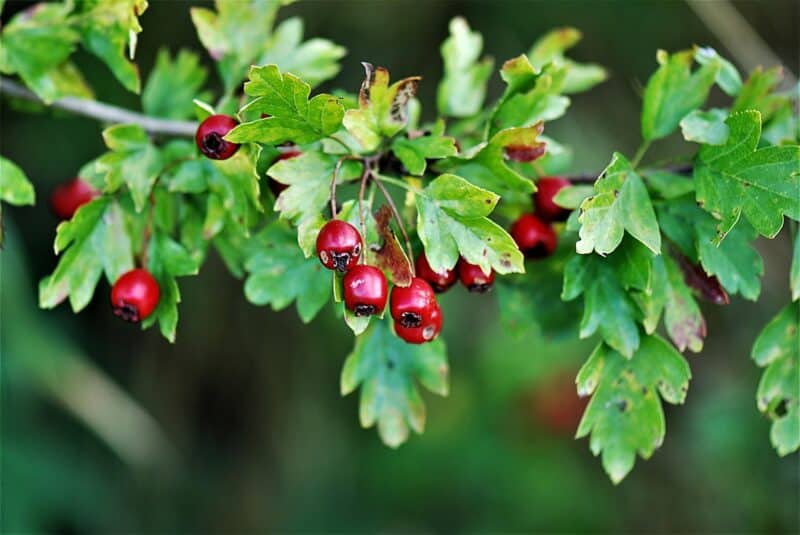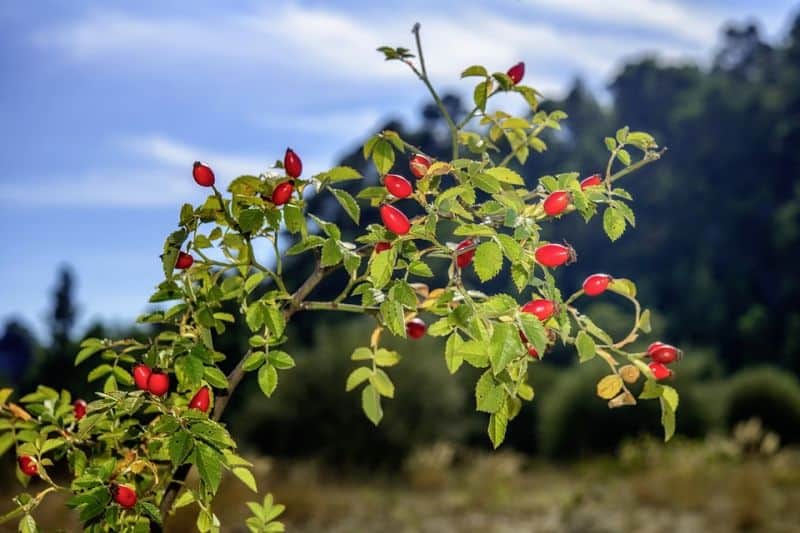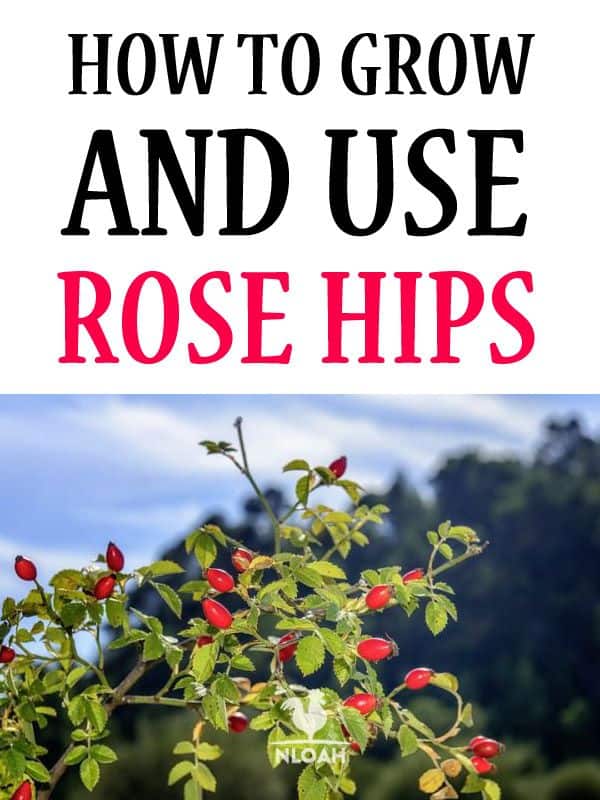Rose hips are a wonderful herb to have on hand in your herbal toolkit. But, how on earth do you get them? You can certainly order them from a variety of health and wellness stores, but what fun is that?
I firmly believe that planting and harvesting your own herbs brings you far more joy than grabbing something off a shelf.

Anyway, rose hips are the seed pods of a rose plant. That’s it. Nothing fancy. However, as simple as they are, these little red-colored beads are chock-full of antioxidants and vitamin C.
For years, folks have been using them in immune-boosting plants and their oil in skin care products. I like to keep rose hips on hand all the time.
Did you know that rose hips themselves aren’t a plant? Nope! They are actually considered to be the fruit of the rose plant.
Not all rose plants are the same and you need to be a bit choosy as to which plant you want to use for harvesting and using rose hips. My personal favorite, and the favorite of many other herbalists out there, is the Rugosa variety of rose plant.
Rugosa roses are hardy and known to spread. You may see them acting as decor for a hedge or fence. But, know this, they are so much more valuable than just a pretty decoration. These roses are perennials and will continue to grow from one season to the next between zones 4 – 7.
Don’t worry, you can enjoy your roses all summer long before you have to mess them up a bit by harvesting the rose hips. Feel free to wait until late August or September, if you wish.
Now, if rugosa roses aren’t your thing, you can use other roses for collecting rose hips from such as roses with tightly packed petals. Tea roses are another good choice.
However, we are going to focus on planting Rugosa roses and using their rose hips in a variety of recipes.
Growing Rugosa Roses
As stated above, Rugosa roses are very hardy. These lovely little flowers even grow in the wild in places that are less than stellar.
You only need to water your Rugosa plants until they become well-established and start to produce new growth. Once that happens, you can decrease watering to only during times of drought; otherwise, your Rugosa’s will take care of themselves.
Containers and Fertilizer
You really don’t need to plant your Rugosas into containers as they tend to grow into large shrubs, however, you may certainly do so if you wish.
Know this, you will need a spacious pot as smaller vessels will not do the job. Your plant needs plenty of room to take root and grow. I would say between 5 and 10 gallons in size for each plant. Ensure that the container has a good drainage mechanism.
Feel free to use regular soil without any added fertilizers. These roses are adaptable and strong. You can add a little sand to help facilitate better drainage.
Pest Problems and Disease Woes
As your roses are in full bloom, you really don’t have to worry about pests bothering them. It’s when the flowers begin to dry up and die that you need to keep a watchful eye. Birds are just as happy to “harvest” the rose hips as you are, and they will make a meal of them.
The best way to avoid having your rose hips chowed down on by birds is to cover your plants with netting. I’ve even used the old fake owl trick to scare off nosey birds.
Granted, thorny plants have their own protective mechanisms in place, but the birds will still try to swoop in and get to them. Better to be safe than sorry.
Beetles love to munch on the leaves of rose bushes. You can pluck them off of your plants by hand or use an insecticide. There are plenty of natural insecticide recipes available if you don’t want to go the Round Up route.
In fact, since you will be eating parts of the plant, I highly recommend that you do use a fungicide or pesticide that is intended for edible plants.
Fungicides come in handy if your rose bushes suffer from stem canker.

Harvesting and Storing Your Rose Hips
I know you are eager to harvest your rose hips, but you must be patient. The first year your roses are planted they aren’t going to render you a very big bounty of rose hips. You won’t see a full crop until the second year.
Once it is time to harvest, I recommend that you wear gloves to avoid getting stuck by thorns. Ouch!
You’ll find most of the hips on the outside of the shrub. After the first frost is the peak time to harvest your rose hips. If you notice the hips looking orange in color, leave them alone, they aren’t ripe enough yet. Deep red rose hips are overripe.
So, you need to be a good judge of color and determine the shade that fits in-between orange and deep red. The hips should not feel mushy but rather slightly soft.
Using clippers, snip the rose hips off each stem. You can spread them out in a sunny area to allow them to dry. Their skins should slightly wrinkle. You can also use a dehydrator if you prefer.
Once the hips are dried, split them open and scrape out the seeds. Allow the rose hips to dry a bit more.
Lastly, once dried, you can store your rose hips in the fridge for 4 to 6 months or freeze them for a year and beyond.
How to Use Rose Hips
Rose hips can be used in a variety of ways both externally and internally. These tiny little buds are packed with vitamin C and antioxidant loving compounds. The following list details some ways you can use rose hips in your daily life.
- Make jam – Rose hip jelly will add a wonderful touch to your morning toast.
- Infuse vinegar with them – Use a rose hip infused vinegar on salads or as a marinade for meats and vegetables.
- Take the edge off with rose hip wine – If you’ve never had rose hip wine before, you’re missing out.
- Treat your dog to the benefits of rose hips – Rose hip dog treats
- Make rose hip oil – Rose hip oil is great for your complexion.
As a bonus, I’m leaving you with a lovely…
Rose hip face mask recipe:
Ingredients
- 20 rose hips
- Filtered water
- 4 tbsps. plain Greek yogurt
Directions
- If you haven’t already, remove the stalk and blossom ends of your rose hips. Give the hips a thorough rinsing with cool water. Toss them into a saucepan and cover them with filtered water. Bring the concoction to a boil and allow to simmer, uncovered, for about 15 minutes or so.
- Drain the water from the rose hips and place them into a blender and pulse into a puree or paste-like texture.
- Allow the pureed rose hips to cool and then mix in the yogurt.
- Apply a thick layer of the mask to your face and neck and let it sit for about 10 to 20 minutes. Rinse the mask off with cool water and gently pat your skin dry with a clean towel.
- Store the leftover rose hip face mask in a small jar or container in your fridge for up to two weeks.
Now you know how to grow, harvest, store, and use rose hips. Here’s to better health and beauty!

Jessica Faidley is a stay-at-home, work-from-home, homeschooling mom who loves to teach her children how to live off the land.
Herbalism is another topic that Jessica has studied. Keeping herself and her family healthy through a natural approach is her way of doing things.

I’m very interested in planting roseship plants.i do have land with water bt my problem is where to find seeds and where I’m going to sell my product after harvesting it.